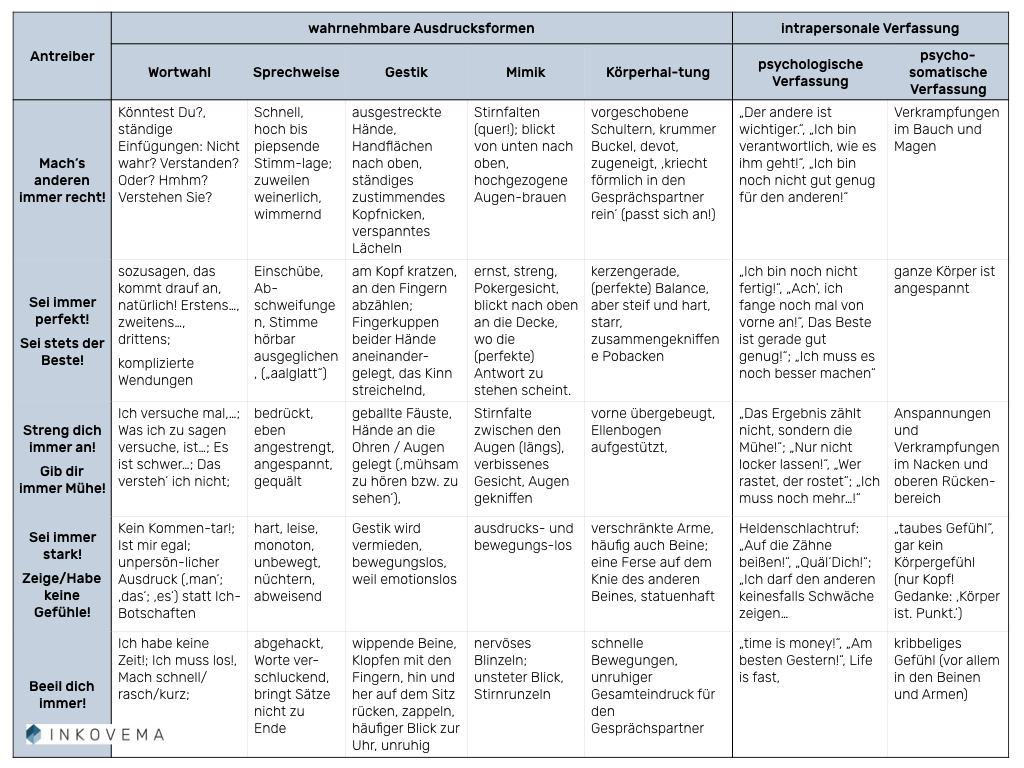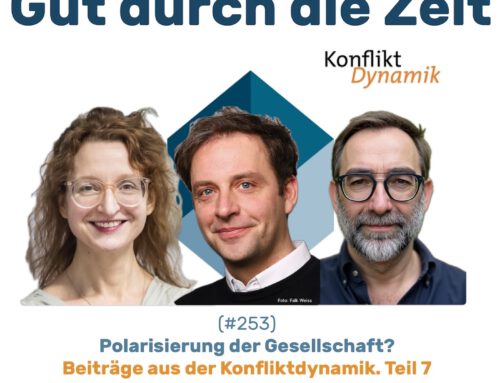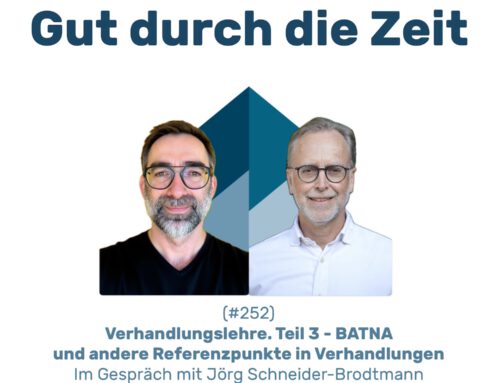The driver concept of transactional analysis as a diagnostic and intervention concept for mediation
With the driver concept, transactional analysis has created an excellent concept that can paradoxical phenomenon and explains that even solutions developed with the best of intentions and once tried and tested sometimes only lead deeper into the mess. When we humans are under psychological, emotional and even more so existential pressure, we do our best to successfully overcome the situation – and yet we are sometimes surprised to realise that we have lost our way hopelessly and are only wandering deeper into the woods, even though we are looking for the exit and it is precisely our efforts that have perpetuated the problematic situation.
What can come across as a terribly nice experience in problem situations is often a tangible social catastrophe in conflicts with others.
This blog post…
(and his two brothers
- The Driver dynamics in the context of transactional analysis and
- The action pentagon or the drivers and counter-drivers united)
This book presents the driver concept of transactional analysis in a comprehensive way and is intended to help mediators and conflict counsellors find a useful map in this maze of problematic solution approaches.
The driver concept by T. Kahler
The concept of drivers originates from Taibi Kahler, an American psychologist and transactional analyst. It is used to identify and diagnose problematic behaviour. Its The core idea is that driving behaviour only leads deeper and deeper into the mess, even though it is subjectively motivated by a solution. As a concept, drivers illustrate the basic impetus of transactional analysis to become autonomous, to free oneself from "foreign", oppressive "powers" like hardly any other concept.
The driver concept is a helpful and – important observation concept for the trained eye – when diagnosing conflict and communication. Although it requires a great deal of attention and therefore practice, it is worthwhile for mediators and professional conflict managers.
From the very beginning Kahler and his colleagues five drivers. Any attempts within the TA community to establish further drivers or to further narrow down these five failed or were ultimately not really recognised.
When TA talks about drivers, it ultimately means driver behaviour, i.e. observable and therefore measurable behaviour. On the one hand, this is important in order to avoid drifting into the speculative and esoteric and, on the other, to avoid assuming that there are real entities called drivers. They don't exist, they are an idea, tied up in a concept to enable comprehensible communication.
In the context of driver behaviour, transactional analysts train themselves over many years to recognise such behaviour, the linguistic formulations, gestures, facial expressions, behaviours, themes and predominant forms of expression. And here they are also pointing the way to the future with artificial intelligence, sensor technology and a large amount of data: transactional analysis has indeed prepared a modern field of research that can be proven with technological progress.
The individual drivers
Taibi Kahler identified (in therapeutic contexts) five behaviours that his clients used to solve problems and conflicts, but which only exacerbated them. He called these behaviour patterns Drivers.
- (Always) please others! (Always) please others Please me!
- Be (always) perfect! Be perfect!
- (Always) try hard! Try hard!
- Be (always) strong! Be strong!
- Hurry up (always)! Hurry up!
In the TA community, it was not always undisputed that there are (only) five drivers. Other drivers were sometimes mentioned, discussed, but ultimately rejected (worth reading about this Schlegel, L./Jucker, R.: The Transactional Analysis, 2011, p. 50.)
Drivers (and their opposite counterparts, so-called counter-drivers, KK 58-A 05) are Behavioural patterns developed as attempts to solve emotionally and existentially distressing situations. were and still are used ("old and proven"). Such emotionally and existentially distressing situations are captured in TA with the concept of "banishing messages", see Schneider ZTA 2006, 21.
Inner driver dynamics are (unconsciously) activated when inner stress is experienced. In doing so, it becomes increasingly entangled in stress-inducing behaviour. Particularly in situations in which calmness, overview, distance and a step-by-step approach would be necessary, the driver-driven behaviour is activated, intensified and thus leads to stress. deeper and deeper into the mess. Driver behaviours are "automated" solution attempts for humansto cope with stress, problems and conflicts that in their origin subjectively represented survival strategies. That is why they are very powerful.
The "Choice" of driving behaviour is a reaction to the behaviour and expectations of important caregivers. The choice is made between the ages of three and six. In adulthood, it is therefore rarely questioned and is one of the "tried and tested" strategies of individual problem-solving behaviour. And they are regularly tried and tested and have many successes to their credit. But they also reach their limits. This is particularly evident in conflict situations in later years.
The five drivers of transactional analysis
1.do right by others (always)!
"Be kind, others are more important, their needs always come first!"
Those who follow this driver make their inner well-being dependent on whether the other person feels comfortable. Full of insecurity, they will keep responding to the other person until they "feel good". Those who "(always) please others", believes that he or she is responsible for the well-being and emotional world of the other person. Just correctly understand the wishes and needs of others (without asking!), how they are actually doing and always know and fulfil their "wishes" in advance! It seems unthinkable that the other person would already be satisfied and happy without this „help“. It is also inconceivable that the do’s-right-driven should think of themselves first before thinking of others! This sometimes leads to socially accepted, albeit dictating, measures (because delay is not tolerated!)!
On the other hand, do not criticise! Not offending others, even if they are trampling through your own personal front garden. To please everyone all the time "is an art that nobody can do"…
Do-it-right people fantasise about the needs of their environment and make it their task to fulfil them - and sometimes they hit the mark.
2. be (always) perfect!
"Do everything exactly and as perfectly as possible!"
Whoever follows this driver, considers mistakes unacceptable, especially his own. There will be no rest until everything is perfect, complete and flawless. And, please, it's best to check again!
Reports are revised four times, discarded and rewritten, the rubbish bin is already overflowing; e-mails take hours, especially the short three-liners take forever, examination and submission deadlines are postponed because there is still a gap in knowledge or could be. Or training, further education, jobs and hobbies are not even started; after all, you would be a beginner! And if you are a beginner, then please do it in the socially secluded basement, in the attic, in secret: No-one must know about it or see what is imperfect. Then it's better not to start at all – or ever get to the end. How many novels of the century lie dormant in the desks of those bored with their jobs and underachieving perfectionists? Oh how much the experimenting digital society has improved here! And how much more quality have we been enriched by creative testing, trying, experimenting and simply doing? So much more!
But back to the perfect driver: expectations must generally be exceeded, everything else is sloppiness. Uncompromising is a predominant trait, especially towards oneself. Tests, drafts, ping-pong in the team... none of this is possible, but is a sign of sloppiness, dilettantism, failure! The perfectionist looks with disgust at the helpless attempts of others – and with fear at his own possibilities of realisation.
3. make an effort (always)!
"Nothing is easy, do everything with a lot of effort, don't give up!"
Those who follow this driver unconsciously work not for the sake of fulfilling their goals, but for the sake of the workload. Work is only good if it is done "by the sweat of one's brow". Life is one of the hardest! Don't complain, fight! Just don't let up, don't feign tiredness, work is effort; what comes easily is worth nothing! Anyone can do that!
Sun, smiles, lightness?! Where are we going! „Taking it easy“ doesn't work at all; when you walk, you feel like you're carrying the world's problems on your shoulders! Atlas is the type where empathic skills are noticeable. Lips are often pressed together, grins are pinched and new topics of conversation are introduced with a heavy sigh. They don't sit down, they literally let themselves go! Everything is heavy. Especially your own briefcase! Business trips can sometimes turn into half-moves for those who are stressed. Digital books? What's the point, it's far too light. Real books are the tomes that reveal their importance in kilograms. Generally speaking, everything is difficult and actually impossible, but we try anyway because we can't manage it anyway. But someone has to! It doesn't help. It has to be done. Sisyphus was basically a happy man! That has to be said.
4. be (always) strong!
"Control yourself, don't feel, do it alone and without complaining!"
Life is an iron consequence. "Even if the world collapses, it will bury the undaunted!" (Schlegel); Bite your teeth, control yourself, don't expose yourself, keep your composure, don't complain, don't cry. "Be strong!" is the call to heroism, the attempt not to feel, not to give room to feelings, even if they cannot be prevented emotionally. And the body is made controllable. „Body control“ – a colourful word for the strong, the pain-free, the tough.
The difference to the hardy? When the hardy come into the garden, they find the hardy, who have been working there for months, already there. When the strong don't feel it, it's the hard-working who always need it.
"Be strong!" kills the living and the humane and gives birth to Spartanism. It is the strong who, in a sense, see themselves as part of the 300 „want to feel“.
5. hurry up (always)!
"Be even faster and do everything at the greatest possible speed!"
Those who follow this driving force are on the move quickly, always and everywhere, literally disappears from the "here and now", displaces itself and sees only loss in the time.
The beat is always high for him, always tightly timed; rhythm is anathema to him, at least the phases of rest and relaxation. Restlessness is his theme, being driven is the word reserved for him and yet he is always late. If there is a break, it is usually forced; it is used as an opportunity to catch up.
Efficiency is his favourite topic, time management systems his arena. And he brings both into disrepute with his activities.
Goodbyes are said while walking, emails are like bombardments, phone calls are volleys of gunfire because he can't listen, let alone record – he's usually already so full, right up to the top.
This is also how he eats: there are no grinding times, only scarfing and stuffing times, if at all. A cigarette does the trick too, hastily while walking, if the smartphone allows it. Eating and sleeping? It's so 20th century!
The (perceptible) driver behaviour
Driver behaviour is precisely recognisable and can be determined using various behavioural indices. Language, choice of words, manner of speaking, facial expressions, gestures, but also posture can be "used" to recognise driver behaviour and react appropriately.
Driver behaviour can also be described as Communication styles be interpreted. As they function subjectively as problem-solving behaviour and tools, they are also to a certain extent Working styles.
Every activated driver is specific, perceptible forms of expression which can be used to draw conclusions about
- the psychological state,
- certain personality traits or even
- Enable problem-solving strategies.
In the transaction-analytical conceptual world, one can refer to the Personality style or underlying Ban messages or others Script elements allow conclusions to be drawn. It should be noted that the perception of only one behavioural indicator is not sufficient to be able to draw conclusions about the corresponding driving behaviour. A reliable diagnosis always requires several corresponding indicators.
Stewart/Joines recommend Three points to consider when observing driver behaviour should be.
- Individual elements can only be observed in fractions of a second,
- Clusters and patterned behavioural cues are helpful,
- What is important is a person's primary driver, not their secondary drivers.
The driver concept in the context of transactional analysis
The concept of drivers is catchy and extremely effective in counselling and mediation. It provides excellent services in the treatment of symptoms of excessive demands and burn-out cases. Nevertheless, it was developed in the context of transactional analysis. Its strength, but also its weakness, becomes understandable against this background.
It is therefore worth considering the concept of drivers in connection with the concepts of the Life scriptsthe Basic settings and the Personality styles to be considered. The drivers were given a special formulation in the Miniscriptwhich Kahler developed himself (see lit.).
Benefits of the driver concept in mediation
On the one hand, the driver concept helps the mediator, to professionalise yourselfby keeping an eye on their own personality traits. In this way, the mediator does not fall into a driven style of working and communicating with the mediants and does not bother them with their problematic personality traits. In pressurised situations, which are not uncommon for mediators in mediations, this is of great value: one's own "drive" is a not insignificant factor in the work of mediators. Awareness and (self-)experience provide support here and allow you to keep a cool head even in heated mediation situations.
The realisation that the driving behaviour is originally based on a problem-solving idea and therefore always has a constructive core is conducive to this. At least the intention is generally to be welcomed and supported. The constructive intentions and moments that can be hidden in driver behaviour are deciphered by the so-called dynamic action pentagon, that the Transaction analyst J. Schneider in the German-speaking TA community.
On the other hand, the Driver concept also as an analysis tool. The many references to observation possibilities during communication in particular provide information about the current conflict situation and dynamics. It is advisable not to confront the drivers directly, but rather to General conditions in mediation in such a way that driver-driven behaviour is not encouraged, but rather avoided.
As a guideline for action, it is advisable not to want to eliminate the driving behaviour, but to design the context in the mediation in such a way that the driving behaviour can be avoided.
If you liked the text, I would be delighted if you would leave a comment and recommend, share and tell others about it!
With best regards!
Sascha






Leave A Comment